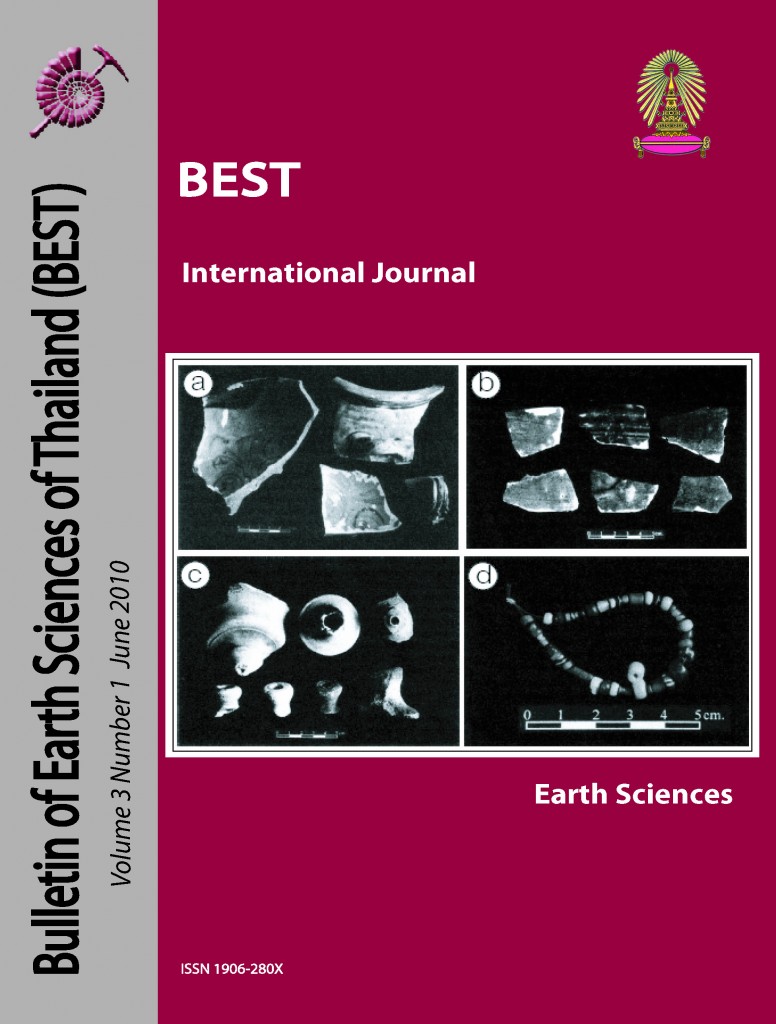Geomorphology and Ground Penetrating Radar Profiles of Holocene Coastal Dune, Western Coastal Plain of the Gulf of Thailand
Main Article Content
Abstract
At Bang Berd Bay, a remarkable wind blown sand dune lies almost parallel to the present coastline with its highest elevation about 20 m above the present mean sea level. The formation of sand dune here has not yet concluded. This paper shows a result of Ground Penetrating Radar (GPR) to visualize the invisible dune structures as well as applying a remote sensing data to map the distribution. As a result from aerial photograph
interpretation, dune morphology shows a majority of parabolic and transverse patterns. GPR profiles revealed some obvious macro-scale sedimentary patterns, clear boundary of dune overlying on the prograded beach ridge plain. Based on macro-scale sedimentary patterns, lee and stoss angles of some burial dunes from GPR signals and dune morphology indicated the direction of wind blown mainly from the east to the west. Series of beach ridges underneath sand dune indicated seaward progradation. This seaward progradation of beach ridges inferred its formation possibly after the mid-Holocene highstand. Thus, the formation of dune may have occurred during a dry condition probably during and after the mid-Holocene regression. OSL datings also reveal that the upper part of dune profile depth at 1-3 m formed between 2,220 to 2,960 years ago.
Article Details

This work is licensed under a Creative Commons Attribution-NonCommercial-NoDerivatives 4.0 International License.
Copyright © 2008 Department of Geology, Faculty of Science, Chulalongkorn University. Parts of an article can be photocopied or reproduced without prior written permission from the author(s), but due acknowledgments should be stated or cited accordingly.
References
Choowong, M., Ugai, H., Charoentitirat, T., Charusiri, P., Daorerk, V., Songmuang, R. and Ladachart, R. 2004. Holocene Biostratigraphical Records in Coastal Deposits from Sam Roi Yod National Park, Prachuap Khiri Khan, Western Thailand. The Natural History Journal of Chulalongkorn University 4(2): 1-18.
Havholm, K. G., Bergstrom, N. D., Jol, H. M. and Running G. L. 2003. GPR survey of a Holocene aeolian/fluvial/lacustrine succession, Lauder Sandhaills, Manitoba, Canada. The Geological Society of London: 47-54.
Hugenholtz, C. H. and Moorman. 2007. Ground penetrating radar (GPR) imaging of the internal structure of an active parabolic sand dune. The Geological Society of America: Special paper 432: 35-45.
Neal, A. 2004. Ground-penetrating radar and its used in sedimentology: principles, problems and progress. Earth-Science Review 66: 261-330.
Orford, J. D., Murdy, J. M. and Wintle, A. G. 2003. Prograded Holocene beach ridges with superimposed dunes in north-east Ireland: mechanisms and timescales of fine and coarse beach sediment decoupling and deposition. Marine Geology 194: 47-64.
Overmeeren, R. A. 1998. Radar facies of unconsolidated sediments in The Netherlands: A radar stratigraphy interpretation method for hydrogeology. Journal of applied geophysics 40: 1-18.
Pederson, K. and Clemmensen, L. B. 2005. Unveiling past aeolian landscapes: A ground-penetrating radar survey of a Holocene coastal dune field system, Thy, Denmark. Sedimentology Geology 177: 57-86.
Tamura, T., Murakami, F., Nanayama, F., Watanabe, K. and Saito, Y. 2008. Groundpenetrating radar profiles of Holocene raised-beach deposits in the Kujukuri strand plain, Pacific coast of eastern Japan. Marine Geology 248: 11-27.

